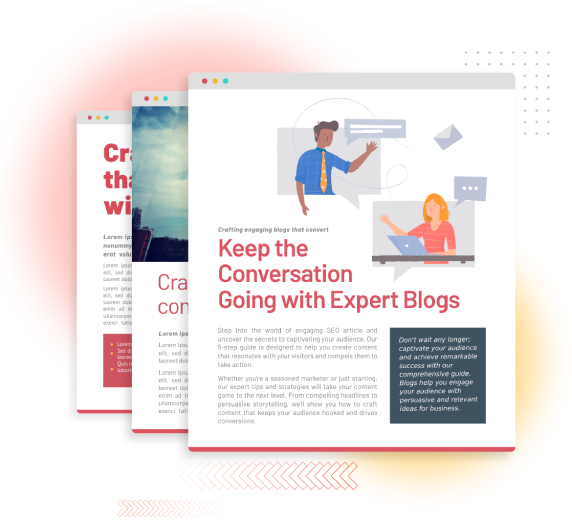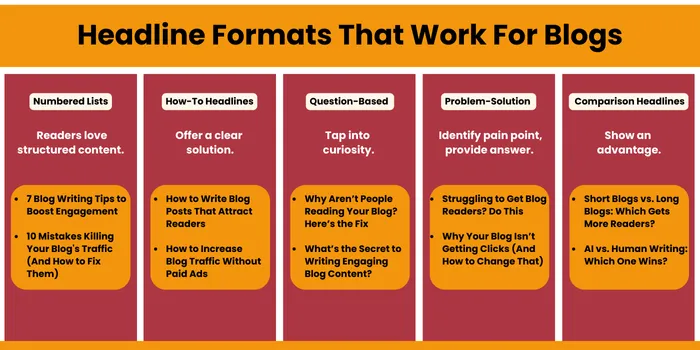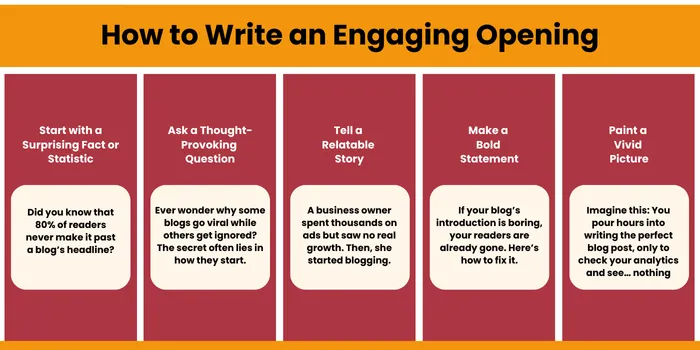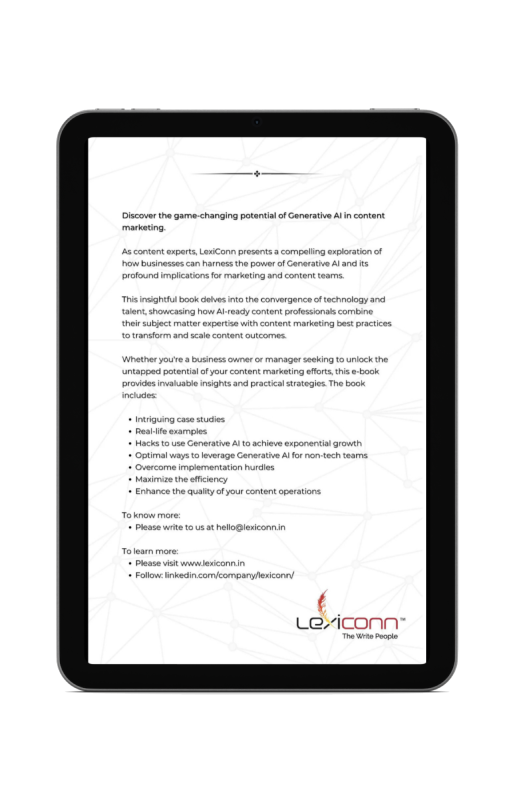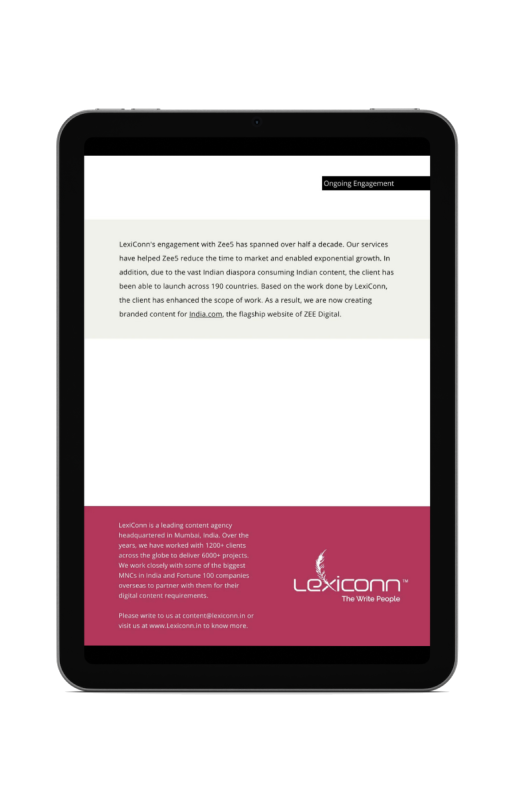A growing e-commerce company had great products, a sleek website, and competitive pricing but struggled with low traffic and conversions despite paid ads and social media efforts. When it started consistently blogging with valuable content like how-to guides and customer success stories, its organic traffic soared, engagement improved, and customers began trusting its brand, leading to higher sales and long-term loyalty.
This isn’t just luck. Blog writing is a game-changer for content engagement and digital storytelling. A well-written blog doesn’t just inform—it attracts, engages, and builds relationships with readers.
So, how does blog writing attract readers and keep them hooked? Here are some tips for engaging blog content to help you with blog writing that stands out.
How to write blog posts that attract readers
1. Know Your Audience
Before you even start typing, take a step back and ask: Who am I writing for? A blog writing that speaks directly to a reader’s needs, interests, and challenges is far more engaging than a generic one-size-fits-all post.
Imagine you’re running a fitness blog. A post titled "5 Exercises for a Stronger Core" might seem relevant, but if your main audience is busy professionals with limited time, they might scroll past it. Now, tweak that title to "5 Quick Core Workouts for Busy Professionals—No Equipment Needed!" Suddenly, it speaks directly to their pain points and lifestyle.
How to Identify Your Audience
Here are some practical ways to figure out what your readers truly want:
- Use Surveys & Polls – Post a poll on Instagram, Twitter, or LinkedIn asking your followers what topics they want to read about. For example, if you’re in the tech space, ask: Would you prefer AI trends or cybersecurity tips?
- Check Analytics – If you already have a website, dive into Google Analytics or social media insights. See which blog topics get the most clicks, longest reading time, and highest shares. If your audience loves “how-to” guides but ignores industry news, focus on what works.
- Join Online Communities – Facebook groups, Reddit, and Quora are goldmines for understanding what questions your target audience is asking. If people frequently post about struggling with work-life balance, a blog post like "How to Manage Your Time Like a CEO" could attract the right readers.
- Read Comments & FAQs – Look at the comments section of popular blogs in your niche. What are people asking? What confuses them? Blog writing that answers real questions will instantly grab attention.
Quick Fix
Before your next blog writing, ask yourself:
🔹 Who is my ideal reader?
🔹 What problem am I helping them solve?
🔹 Where do they typically search for information?
2. Craft a Captivating Headline
Your headline is the first impression your blog writing makes, and in a sea of content, it must stand out. A weak headline means your post might never get clicked—no matter how great the content is. But a strong headline? It grabs attention, sparks curiosity, and makes the reader think, I need to read this!
What Makes a Headline Engaging?
An effective headline should:
- Be Clear – Readers should instantly understand what the blog writing is about. Avoid vague or overly clever titles that confuse rather than inform.
- Spark Curiosity – Give readers a reason to click, but don’t give everything away. A headline like “The Simple Writing Trick That Boosts Engagement by 80%” teases the benefit without revealing the entire secret.
- Promise Value – Show the reader why this post is worth their time. “How to Write Blog Posts That Attract Readers” tells them exactly what they’ll learn.
- Use Strong Words – Words like “proven,” “ultimate,” “secret,” and “powerful” add impact. Compare:
Avoid: Ways to Improve Your Blog
Use: 10 Powerful Ways to Instantly Improve Your Blog
- Be Concise – Aim for 6-12 words. Long headlines get cut off in search results and lose impact.
Headline Formats That Work
Not sure where to start? Try these proven headline structures:
- Numbered Lists: Readers love structured content.
- 7 Blog Writing Tips to Boost Engagement
- 10 Mistakes Killing Your Blog's Traffic (And How to Fix Them)
- How-To Headlines: Offer a clear solution.
- How to Write Blog Posts That Attract Readers
- How to Increase Blog Traffic Without Paid Ads
- Question-Based Headlines: Tap into curiosity.
- Why Aren’t People Reading Your Blog? Here’s the Fix
- What’s the Secret to Writing Engaging Blog Content?
- Problem-Solution Headlines: Identify a pain point and provide an answer.
- Struggling to Get Blog Readers? Do This
- Why Your Blog Isn’t Getting Clicks (And How to Change That)
- Comparison Headlines: Show an advantage.
- Short Blogs vs. Long Blogs: Which Gets More Readers?
- AI vs. Human Writing: Which One Wins?
3. Hook Readers with a Strong Opening
Your headline may get the click, but your opening decides if readers stay. The first few sentences are your make-or-break moment—a weak start, and they’re gone. A strong one? They’re hooked.
How to Write an Engaging Opening
Instead of a generic introduction ("Blogging is important for businesses today…"), grab attention right away with one of these approaches:
- Start with a Surprising Fact or Statistic
People love numbers. A strong data point makes your blog writng feel credible and instantly interesting.
Example:
"Did you know that 80% of readers never make it past a blog’s headline? That means your introduction has to work twice as hard to keep them engaged."
- Ask a Thought-Provoking Question
Questions make readers stop and think.
Example:
"Ever wonder why some blogs go viral while others get ignored? The secret often lies in how they start."
- Tell a Relatable Story
A quick, engaging story helps readers see themselves in your content.
Example:
"A business owner spent thousands on ads but saw no real growth. Then, she started blogging—and her organic traffic doubled in just a few months. What changed? She mastered the art of content engagement."
- Make a Bold Statement
Strong opinions or controversial takes spark curiosity.
Example:
"If your blog’s introduction is boring, your readers are already gone. Here’s how to fix it."
- Paint a Vivid Picture
Use sensory details to pull readers in.
Example:
"Imagine this: You pour hours into writing the perfect blog post, only to check your analytics and see… nothing. No clicks, no engagement. Frustrating, right?"
What to Avoid in Your Blog Introduction
- Generic Statements ("Blogs are a great way to share information.")
- Overly Long Openings – Get to the point fast.
- Talking About Yourself First – Readers care about what’s in it for them.
4. Write in a Conversational Tone
Nobody wants to read something that feels like a textbook. If your blog writng sounds robotic or overly formal, readers will tune out. The best blog writing feels like a friendly conversation—easy to read, engaging, and full of personality.
How to Make Your Writing More Conversational
- Write Like You Talk
Imagine you’re explaining your topic to a friend over coffee. Would you say, "Utilizing strategic methodologies to enhance content engagement yields optimal results"? Nope. You’d probably say, "Want more people to read your blog? Here’s how to make it interesting."
- Use Simple, Clear Language
Readers shouldn’t need a dictionary to get through your post. Keep sentences short and straightforward.
Avoid: "This article aims to elucidate the various methodologies for crafting engaging digital narratives."
Use: "Here’s how to write blog posts people actually want to read."
- Use Contractions
Formal writing says, "You are going to love these blog writing tips."
Conversational writing says, "You’re going to love these blog writing tips."
See the difference? It feels more natural.
- Ask Questions to Keep Readers Engaged
Good writing feels interactive. Asking questions makes readers think and feel involved.
Example: "Ever wonder why some blogs go viral while others get ignored?"
- Inject Personality
A little humor, a relatable example, or a personal touch can make your writing more engaging.
Example: "Blog writing without personality is like serving plain toast—technically fine, but kind of boring. Let’s add some flavor."
What to Avoid
- Jargon & Complex Words – If it’s not something you’d say in everyday conversation, simplify it.
- Overly Formal Tone – This isn’t an academic paper. Keep it friendly.
- Long, Complicated Sentences – Break them up for better readability.
5. Make It Scannable
Most readers don’t read every word, they skim first, looking for the most important bits. If your blog writing is a giant block of text, they’ll bounce before they even start.
How to Make Your Blog Writing Easy to Scan
- a. Use Subheadings
Break your content into sections with clear subheadings. Instead of this:
Avoid: "Tips for Writing a Blog"
Try: "How to Write a Blog That Attracts Readers"
- Write Short Paragraphs
Big walls of text are overwhelming. Stick to 2-3 sentences per paragraph to keep things digestible.
- Use Bullet Points & Lists
Lists make content easier to absorb at a glance. Compare:
Avoid: "To create engaging blog content, use subheadings, short paragraphs, bullet points, and bold text to highlight key takeaways."
Try:
- Use subheadings for structure
- Keep paragraphs short
- Add bullet points to highlight key tips
- Use bold text for emphasis
- Highlight Key Takeaways
Make important points stand out using bold, italics, or callout boxes.
Example:
Avoid: "Headlines should be clear and compelling to attract readers."
Try: "Your headline is your first impression—make it clear, compelling, and impossible to ignore."
What to Avoid
- Long, Dense Paragraphs – If it looks hard to read, people will skip it.
- No Formatting – Plain text with no subheadings, lists, or bold highlights is tough to scan.
- Too Many Styles – Avoid overloading with bold, italics, and colors. Keep it clean.
6. Add Value with Actionable Takeaways
Readers don’t just want information—they want solutions. The best blogs go beyond theory and give practical steps people can use right away. If your content doesn’t help readers do something, they won’t come back for more.
How to Make Your Blog More Actionable
- Provide Step-by-Step Instructions
Instead of just explaining a concept, walk readers through the process.
Example:
Avoid: "Use keywords in your blog for better SEO."
Try: "Here’s how to find and use the right keywords:
- Use tools like Google Keyword Planner to find relevant terms.
- Naturally include them in your title, headings, and body.
- Avoid stuffing too many keywords—keep it natural."*
- End Each Section with an Action Step
Make it clear what readers should do next.
Example:
"Now that you know how to structure a blog, go back to your last post and break long paragraphs into shorter ones."
- Use Checklists
Readers love checklists because they make action easy.
Example:
✔ Write a strong headline
✔ Use subheadings for structure
✔ Keep paragraphs short
✔ Add bullet points
✔ Highlight key takeaways in bold
- Offer Downloadable Resources
Templates, worksheets, or cheat sheets make content even more useful.
Example: "Download our free blog-writing checklist to make your next post shine!"
What to Avoid
- Vague Advice – If readers can’t apply it right away, it’s not actionable.
- Too Much Theory – Balance insights with real-world applications.
- No Clear Next Steps – Don’t just inform; help readers take action.
7. Use Engaging Visuals
Images, infographics, and videos can transform your content by making it more engaging and easier to understand. They’re especially helpful in breaking down complex ideas and keeping readers interested. To make your visuals work harder for you, ensure they serve a clear purpose.
How to Make Your Content More Visual
- Select Relevant, High-Quality Images
Instead of just adding any image, choose ones that enhance or clarify your message. Ensure they’re sharp, relevant, and branded.
- Example: If you’re writing about SEO tips, include a clear infographic that shows a keyword search process.
- Use Visuals to Break Up Text
Long blocks of text can overwhelm readers. Break them up with visuals like images, charts, or icons to keep the content digestible.
- Example: After a paragraph explaining a concept, add an image that illustrates the point to make it easier to remember.
- Incorporate Step-by-Step Visuals
Use visuals to explain processes or steps. Whether it's a diagram, a flowchart, or a video, breaking down complex steps with images makes them easier to follow.
- Example: Use a visual flowchart to show how your product works, with each step clearly labeled.
- Leverage Video Content
Short videos can capture attention and explain complex ideas in a more dynamic way than text alone.
- Example: Create a video that gives a quick tutorial on how to optimize images for faster page loading.
What to Avoid
- Overloading with Unnecessary Visuals – Only use visuals that add value. Don’t crowd your content with too many images or videos that distract from the main point.
- Using Low-Quality or Irrelevant Images – Avoid pixelated or off-brand visuals. Poor-quality images can hurt your credibility and confuse the reader.
- Lack of Context or Explanation – Just placing visuals without context isn’t helpful. Always pair images with explanations or captions so the reader understands the takeaway.
8. Optimize for SEO Without Overstuffing
SEO is essential for getting your content seen by a wider audience, but keyword stuffing can negatively affect your readability and user experience. Striking the right balance between optimizing for search engines and maintaining high-quality, engaging content is key.
How to Optimize for SEO Without Overstuffing
- Include Primary Keywords in Key Areas
Naturally incorporate primary keywords in your headlines, subheadings, and throughout the body of the post. This helps search engines understand the focus of your content while maintaining a smooth flow for readers.
- Example: Instead of repeating your main keyword awkwardly, like “blog writing blog writing tips,” use variations like “tips for writing blogs” or “how to improve your blog writing.”
- Focus on Readability
Your content should be easy to read first and foremost. Avoid cramming keywords into every sentence. Prioritize providing value through your writing while keeping SEO in mind.
- Example: "A well-structured blog post can improve SEO" is much more reader-friendly than “A well-structured blog post that is optimized for SEO can greatly improve your blog SEO.”
- Use Meta Descriptions Effectively
Write compelling meta descriptions with your primary keyword. These short snippets give search engines and users a preview of what your post is about, making it more likely they’ll click through.
- Example: “Learn effective blog writing tips to boost your content’s readability and SEO rankings.”
- Optimize Image Alt Text
For each image you include, make sure you’re using descriptive alt text with relevant keywords. This not only helps with SEO but also makes your content accessible to all users.
- Example: If your image is about blog writing, your alt text might read, “steps to create an SEO-friendly blog post with relevant keywords.”
- Use Variations of Keywords
Avoid using the same keyword repetitively. Use variations, synonyms, or related terms to avoid keyword stuffing while still helping search engines understand your topic.
- Example: Use “SEO strategies,” “content optimization,” and “improve search rankings” instead of repeating “SEO” throughout the article.
What to Avoid
- Keyword Stuffing – Don’t force keywords into your content in a way that disrupts the flow. This can make your content feel unnatural and is a red flag for search engines.
- Ignoring User Experience – SEO is important, but don’t let it come at the cost of readability. If your content is hard to follow, users won’t engage with it, which can hurt your rankings in the long run.
- Overlooking Other SEO Elements – While keywords are essential, also focus on other important factors like page load speed, mobile-friendliness, and quality backlinks for a holistic SEO strategy.
Ready to Boost Your Blog? Let LexiConn Help You Grow
Creating blog content that truly engages readers isn’t just about writing—it’s about connecting with your audience, offering them something of value, and keeping them interested. With the right strategies, like knowing your audience, using catchy headlines, breaking up the text with visuals, and giving them something actionable, your blog can go from average to outstanding.
If you’re looking for help to make your blog shine, LexiConn is here for you. We specialize in crafting blog posts that not only get attention but also keep your readers coming back. Here’s what we can do for you:
- Custom Blog Contentthat speaks your brand’s language
- SEO Optimization to help you get discovered
- Eye-catching Visuals like images and infographics that tell your story
- Practical, Actionable Tips that your readers can immediately use
- Regular Content to keep your audience engaged and excited
- Strategic Planning to make sure your blog works for your business
Let’s turn your blog into a powerful tool that grows your audience and boosts your brand. Get in touch with LexiConn today to get started!
Boost your Content Strategy.
Download the Free eBook now.
Unlock Generative AI's potential for content marketing success. Unearth its impact on teams and businesses. Witness real-life examples and case studies, showcasing AI-driven content ingenuity.
